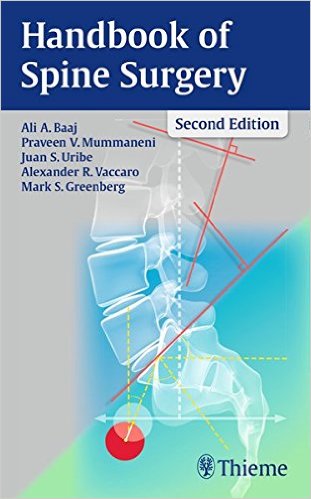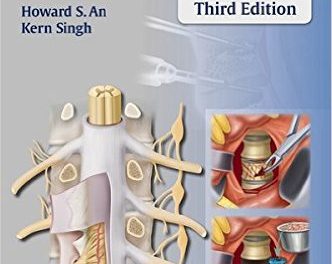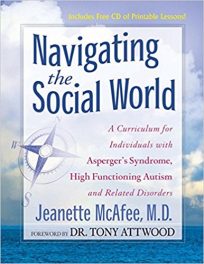Editors: Ali A. Bajaj, MD; Praveen V. Mummaneni, MD; Juan S. Uribe, MD; Alexander R. Vaccaro, MD; and Mark S. Greenberg, MD
Publisher: Thieme – 533 pages, with 196 images
Book Review by: Nano Khilnani
This book distills the basic principles of present-day spine surgery. In addition, it presents surgical and medical techniques, making it an excellent reference before surgery. This handy guide also serves as a reliable daily companion guiding surgeons and residents who care for patients with spinal disorders, to do superior work.
It consists of chapters written by 136 spine specialists in the United States, and six countries – Brazil, Canada, Colombia, Egypt, Greece, Taiwan – and the United States territory of Puerto Rico.
This work contains an immense amount of information presented in 72 chapters spread on 533 pages, but it is competently and skillfully organized by the five editors named above in a compact and ready-to-refer, portable package. About half of the length of this book is devoted to surgical procedures, with numerous helpful illustrations.
To give you an overview, we name below the titles of its four main sections and three appendices:
- Anatomy: chapter 1 to 6
- Clinical Spine Surgery: chapters 7 to 17
- Spinal Pathology: chapters 18 to 33
- Surgical Techniques: chapters 34 to 72
Appendices:
- Positioning
- Spinal Othoses
- Outcome Scales
The key features of this second edition of the book are:
- New chapters on adult degenerative deformity, pediatric scoliosis, and radiographic principles of deformity
- Expanded spinal trauma section now includes separate chapters on cervical, thoracolumbar, and sacropelvic injuries
- Common clinical questions (with answers) at the end of each chapter highlight topics frequently encountered in the operating room and on board exams
- Easy-to-read bulleted format
Content in the chapters follow a systematic template that typically includes the following:
- Key Points
- Indications
- Techniques
- Complications
- Postoperative Care
- Outcomes
- Surgical Pearls
- Common Clinical Questions and Answers
- Key References
This system of organizing materials enables users to search for answers to questions they may have in an efficient way, and makes it ideal for them to get quick and easy reviews. This book is more useful with this format particularly for users who are say, third-year medical students or physician assistants.
You will find mainly bulleted, specific, and targeted information under each heading, Let’s take look at the headings in a typical chapter such as Chapter 6, Sacral-Iliac Spine:
- Key Points
- Bony Anatomy
- Neural Anatomy
- Vascular Anatomy
- Ligamentous and Muscular Anatomy
- Surgical Pearls
- Common Clinical Question
- Answer to Common Clinical Question
- References
This is really an excellent book on various aspects of surgery relating to the spine.
Editors:
Ali A. Bajaj, MD is Assistant Professor in the Department of Neurological Surgery at Weill Cornell Medical College, and Professor of Adult and Spine Surgery at New York Presbyterian Hospital in New York, New York.
Praveen V. Mummaneni, MD is Professor and Vice-Chairman of the Department of Neurosurgery at University of California San Francisco; and Co-Director of UCSF Spine Center in San Francisco, California.
Juan S. Uribe, MD is Associate Professor and Director of the Spine Section in the Department of Neurosurgery at the University of South Florida in Tampa, Florida.
Alexander R. Vaccaro, MD, PhD, MBA is Richard H. Rothman Professor and Chairman of the Department of Orthopedic Surgery, Professor of Neurosurgery and Co-Chief of Spine Surgery at Sidney Kimmel Medical Center at Thomas Jefferson University; Co-Director of the Delaware Valley Spinal Cord Injury Center; and President of the Rothman Institute in Philadelphia, Pennsylvania.
Mark S. Greenberg, MD is Associate Professor in the Department of Neurosurgery and Brain Repair at the University of South Florida in Tampa, Florida.







